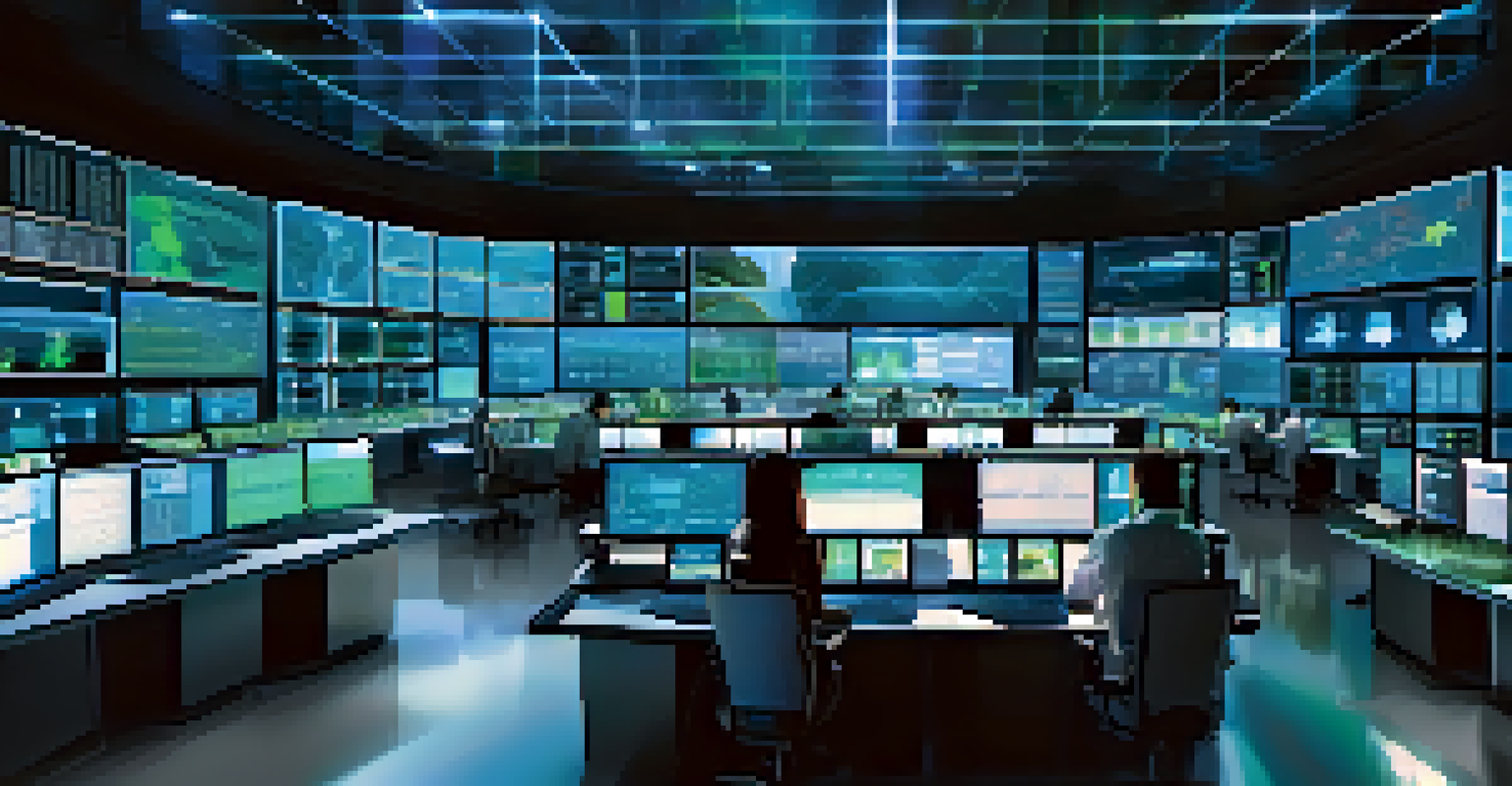The Role of Cyber-Physical Systems in Energy Efficiency Strategies

Understanding Cyber-Physical Systems and Their Importance
Cyber-Physical Systems (CPS) seamlessly integrate computing, networking, and physical processes. Essentially, they represent a blend of the digital and physical worlds, where sensors and actuators communicate with software to optimize functionality. This integration is crucial in today's energy landscape, as it allows for real-time monitoring and control of energy systems.
The future is already here — it's just not very evenly distributed.
Imagine a smart thermostat that not only adjusts your home’s temperature but also learns your patterns and communicates with the energy grid. This example illustrates how CPS can enhance energy efficiency by making informed decisions based on data. As a result, energy consumption can be reduced, leading to significant cost savings and a lower carbon footprint.
In essence, the role of CPS in energy efficiency strategies is to create a more responsive and intelligent energy ecosystem. By utilizing technology to bridge the gap between the physical and digital realms, businesses and consumers can benefit from smarter energy management practices.
How CPS Enhances Energy Management in Smart Grids
Smart grids are revolutionizing the way energy is distributed and consumed. By incorporating CPS, smart grids can analyze vast amounts of data to optimize electricity flow. This means that energy can be distributed more efficiently, reducing waste and ensuring that supply meets demand effectively.

For example, during peak usage times, smart grids can redirect energy from less critical areas to where it's needed most. This dynamic management is a game-changer, helping to prevent outages and lowering the need for excess energy generation, which often comes from less sustainable sources.
CPS Integrates Energy Systems Efficiently
Cyber-Physical Systems (CPS) combine digital and physical processes to optimize energy management and enhance efficiency.
Ultimately, integrating CPS into smart grids leads to increased reliability and efficiency. By harnessing advanced technologies, we can create a more resilient energy system that not only meets our current needs but also paves the way for future sustainability.
The Role of IoT in Cyber-Physical Systems for Energy Efficiency
The Internet of Things (IoT) plays a pivotal role in the functioning of CPS. With IoT devices connected throughout energy systems, they gather valuable data on consumption patterns and system performance. This data enables organizations to identify inefficiencies and make informed decisions that enhance energy efficiency.
We cannot solve our problems with the same thinking we used when we created them.
Consider a factory equipped with IoT sensors that monitor machine performance. If a machine is consuming more energy than necessary, the system can alert operators to investigate and address the issue. This proactive approach not only reduces energy costs but also extends the lifespan of equipment.
By leveraging IoT technology within CPS, businesses can achieve a more sustainable operation. The continuous feedback loop created by these systems allows for constant optimization, ensuring that energy resources are used wisely and effectively.
Energy Efficiency in Buildings through Cyber-Physical Systems
Buildings are significant consumers of energy, and CPS can transform how they operate. Smart building technologies utilize sensors and automation to manage heating, cooling, and lighting based on occupancy and usage patterns. This level of control dramatically reduces energy waste and enhances comfort for occupants.
For instance, a smart office building might use occupancy sensors to automatically adjust lighting and climate control based on the number of people present. This not only cuts down on energy usage but also creates a more pleasant working environment. Employees are more likely to be productive when their comfort is prioritized.
IoT's Role in Energy Optimization
The Internet of Things (IoT) provides critical data that helps organizations identify inefficiencies and improve energy usage.
By implementing CPS in building management, we can create structures that are not only energy-efficient but also adaptable to the needs of their inhabitants. This integration of technology into our buildings represents a significant step towards sustainable urban living.
Challenges and Solutions in Implementing CPS for Energy Efficiency
While the benefits of CPS in energy efficiency are clear, implementing these systems comes with challenges. Issues like interoperability between devices, data security, and high initial costs can deter organizations from fully embracing CPS technologies. Addressing these concerns is vital for widespread adoption.
For instance, ensuring that different IoT devices can communicate effectively requires standardized protocols and frameworks. Additionally, investing in robust cybersecurity measures is essential to protect sensitive data from potential threats. Organizations must prioritize these aspects to foster a secure and efficient energy ecosystem.
By acknowledging and addressing these challenges, businesses can unlock the full potential of CPS. With the right strategies in place, integrating these systems can lead to a more energy-efficient and sustainable future.
The Future of Cyber-Physical Systems in Energy Efficiency
Looking ahead, the role of CPS in energy efficiency is only set to grow. As technology advances, we can expect even more sophisticated systems that can predict energy needs and optimize usage in real-time. This evolution will help address the increasing global demand for energy while minimizing environmental impact.
For example, emerging technologies like machine learning and artificial intelligence will enhance CPS capabilities, allowing for more accurate forecasts of energy consumption patterns. This information will enable smarter grid management and more efficient resource allocation, ultimately leading to greater sustainability.
CPS Drives Sustainable Future
Embracing CPS technologies is essential for creating resilient energy systems that align with sustainability goals.
The future of energy systems lies in the continued integration of CPS, where technology not only meets our needs but also aligns with our sustainability goals. As we move forward, embracing these innovations will be crucial in creating a greener planet.
Case Studies: Successful CPS Implementations in Energy Efficiency
To illustrate the impact of CPS on energy efficiency, let’s look at a few successful case studies. One notable example is the implementation of CPS in a large manufacturing facility, where sensors were used to monitor energy consumption across various machines. By analyzing this data, the facility was able to reduce energy costs by nearly 25% within the first year.
Another case involves a smart city initiative that integrated CPS into its public transportation system. By using real-time data to optimize routes and schedules, the city decreased fuel consumption and emissions. This approach not only improved efficiency but also enhanced the overall commuter experience.

These examples show that the potential of CPS in energy efficiency is not just theoretical; it's being realized in real-world applications. By learning from these successful implementations, other organizations can follow suit and contribute to a more sustainable future.
Conclusion: Embracing Cyber-Physical Systems for a Sustainable Future
In conclusion, cyber-physical systems are transforming how we approach energy efficiency. By integrating technology into our energy systems, we can optimize resource usage and reduce waste. The potential benefits are immense, ranging from cost savings to significant environmental impact.
As we face the challenges of climate change and resource scarcity, embracing CPS technologies becomes increasingly imperative. By investing in these systems, organizations not only enhance their operational efficiency but also contribute to a more sustainable future for everyone.
The journey towards energy efficiency is a collective effort, and cyber-physical systems play a crucial role in this endeavor. Together, we can harness the power of technology to create resilient and sustainable energy solutions.